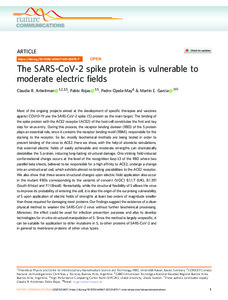| dc.date.accessioned | 2022-02-03T06:34:03Z | |
| dc.date.available | 2022-02-03T06:34:03Z | |
| dc.date.issued | 2021-09-13 | |
| dc.identifier | doi:10.17170/kobra-202201215582 | |
| dc.identifier.uri | http://hdl.handle.net/123456789/13590 | |
| dc.description.sponsorship | Gefördert durch den Publikationsfonds der Universität Kassel | |
| dc.language.iso | eng | |
| dc.rights | Namensnennung 4.0 International | * |
| dc.rights.uri | http://creativecommons.org/licenses/by/4.0/ | * |
| dc.subject.ddc | 500 | |
| dc.title | The SARS-CoV-2 spike protein is vulnerable to moderate electric fields | eng |
| dc.type | Aufsatz | |
| dcterms.abstract | Most of the ongoing projects aimed at the development of specific therapies and vaccines against COVID-19 use the SARS-CoV-2 spike (S) protein as the main target. The binding of the spike protein with the ACE2 receptor (ACE2) of the host cell constitutes the first and key step for virus entry. During this process, the receptor binding domain (RBD) of the S protein plays an essential role, since it contains the receptor binding motif (RBM), responsible for the docking to the receptor. So far, mostly biochemical methods are being tested in order to prevent binding of the virus to ACE2. Here we show, with the help of atomistic simulations, that external electric fields of easily achievable and moderate strengths can dramatically destabilise the S protein, inducing long-lasting structural damage. One striking field-induced conformational change occurs at the level of the recognition loop L3 of the RBD where two parallel beta sheets, believed to be responsible for a high affinity to ACE2, undergo a change into an unstructured coil, which exhibits almost no binding possibilities to the ACE2 receptor.
We also show that these severe structural changes upon electric-field application also occur in the mutant RBDs corresponding to the variants of concern (VOC) B.1.1.7 (UK), B.1.351 (South Africa) and P.1 (Brazil). Remarkably, while the structural flexibility of S allows the virus to improve its probability of entering the cell, it is also the origin of the surprising vulnerability of S upon application of electric fields of strengths at least two orders of magnitude smaller than those required for damaging most proteins. Our findings suggest the existence of a clean physical method to weaken the SARS-CoV-2 virus without further biochemical processing.
Moreover, the effect could be used for infection prevention purposes and also to develop technologies for in-vitro structural manipulation of S. Since the method is largely unspecific, it can be suitable for application to other mutations in S, to other proteins of SARS-CoV-2 and in general to membrane proteins of other virus types. | eng |
| dcterms.accessRights | open access | |
| dcterms.creator | Arbeitman, Claudia Roxana | |
| dcterms.creator | Rojas, Pablo | |
| dcterms.creator | Ojeda-May, Pedro | |
| dcterms.creator | Garcia, Martin Ezequiel | |
| dc.relation.doi | doi:10.1038/s41467-021-25478-7 | |
| dc.subject.swd | SARS-CoV-2 | ger |
| dc.subject.swd | Virologie | ger |
| dc.subject.swd | Mikrobiologie | ger |
| dc.subject.swd | Elektrisches Feld | ger |
| dc.subject.swd | Verwundbarkeit | ger |
| dc.type.version | publishedVersion | |
| dcterms.source.identifier | eissn:2041-1723 | |
| dcterms.source.journal | Nature communications | eng |
| dcterms.source.volume | 12 | |
| kup.iskup | false | |
| dcterms.source.articlenumber | Article number 5407 | |


